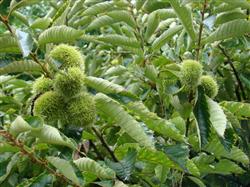When will the Chinese chestnut be grafted?

When will the Chinese chestnut be grafted? Please introduce the method that the grafting of Chinese chestnut is usually carried out in spring, but the survival rate of grafting in spring is not high due to the bad weather of low temperature and rain and man-made technical factors in spring. The author carried out grafting experiments in the summer of 2003-2005, and the survival rates were 79% in 2003, 76% in 2004 and 82% in 2005. After the grafting survived, the branches grew strong, the crown formed quickly, the fruit was early, and the grafting achieved good results in summer. The main technical points are summarized as follows, which can be used as a reference for chestnut producers. 1. The grafting time is about 15 days from late May to early June. 2. Scion selection and rootstock pruning selection for many years, the vegetative branches in the middle and upper part of the outer middle and upper part of the strong mother tree with high yield, stable yield and good quality are required to be fully developed, with protruding bud eyes and fuller shoots, with a branch length of 25ml 30 cm and a branch diameter of 0.8ml 1.2 cm. The scion can be used as you pick it, and you can't stay long. The dense and improperly positioned branches on the rootstock were cut off from the base, leaving branches of basically the same size, oblique in four directions, four branches with a branching angle of 45 ~ 50 degrees, the lowest branch 30 ~ 40 cm from the ground, and each branch with a length of 40 ~ 50 cm. All the leaves on the rootstock were retained, only two branchlets were retained under each grafting cut as auxiliary branches, and the rest of the branchlets were cut off from the base. Third, the main technical link of grafting is the cutting of buds, cutting the leaves of the scion from the base, leaving leaf stalks, but not by hand, so as not to leave leaf marks and cause scion wounds. Then cut off the two ends of the scion and leave four fuller buds in the middle for single bud cutting. The grafted buds are cut into broken buds and grafted with a single bud, and the cut buds are grafted immediately, which cannot be released for a long time and do not need to be soaked in clean water. Film bandaging, the selection of specifications for 3mm plastic film, moderate thickness, good toughness, easy to operate, not easy to tear, firm binding. Pay attention to the budding eyes when bandaging. 4. Manage the grafting after grafting, check it every 5 days, and wipe out the sprouts on the rootstock as soon as possible. When the buds germinate, the auxiliary branches are cut off from the base and the new shoots are managed well. Matters needing attention in new shoot management: ① when the new shoot is about 15ml 20cm, carry out coring to promote branching. Due to the abundant nutrients of summer shoots and luxuriant long leaves of ②, the new shoots are easily broken by strong winds and heavy rain, so they are bound and fixed with sticks. When sprouting multiple shoots of ③, it should be weak and strong, oblique and straight, so as to accelerate the healing of grafting interface. ④ controls new shoots caused by inchworm, jumping beetle, powdery mildew and other diseases. In order to supplement plant nutrition and be beneficial to strong shoots, ⑤ needed topdressing 1Mel twice, urea 100g plus compound fertilizer 150g and organic fertilizer 2.5kg. After rain, the first topdressing was in the green stage of new shoots and the second was in the germination stage of secondary shoots. The unbinding of ⑥ should be about 10 days before sprouting in the following spring. At the same time, continue to erase the sprouts from the rootstocks. Click to get more chestnut planting techniques click to get more fruit planting techniques
- Prev

How to fertilize Chinese chestnut in summer?
How to fertilize Chinese chestnut in summer? Summer is the exuberant period of flowering, fruiting and branch growth of Chinese chestnut, and it is also the first peak period of root growth of chestnut. Lack of nutrition will affect the normal growth of chestnut, resulting in an increase in the number of empty bracts of chestnut.
- Next

How to control the chestnut peach borer?
How to control the chestnut peach borer? Please give guidance to Pyralidae, which belongs to Lepidoptera. The larvae eat chestnut fruit, accumulate insect droppings in the seeds, which is unedible, and cause fruit drop, which has a great impact on the yield and quality. The host also has peach, plum, pear fruit, sunflower disk, corn stalk and so on. Form.
Related
- Moge, come on! The staff of the peasant association in the producing area of cantaloupe were frightened when the crowd gathered.
- Causes and Solutions of low Fruit setting rate of Apple
- Symptoms and control measures of passion fruit virus disease
- Fruit growing lesson: how do apple orchards keep high yields?
- Can you build orchards in the mountains? What are the pros and cons?
- How to manage the coloring period of Crisson grape?
- This paper introduces the processing technology of two kinds of fig products.
- How much is a month for retired teachers in rural areas by 2020?
- How can strawberry planting increase sugar content? We should pay attention to management in many aspects.
- What are the cultivation techniques on how to improve the yield of golden fruit?

